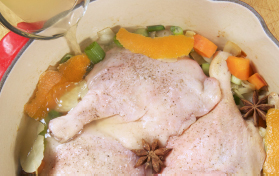HOT AND SOUR
BRAISED DUCK LEGS
WITH ORANGE ZEST AND CHILES
THIS IS A CHINESE-STYLE DISH, BUT IT FEATURES A GREAT all-purpose technique that can be used for any duck legs, regardless of the flavors you add. The duck legs can even be served as is, without being tossed in the pungent sauce. And the sauce would work well swapping in braised pork belly (here) in place of the duck, or even chicken.
As in many poultry braises, the “searing” stage happens at the end of the braise rather than at the beginning. The legs are braised for 90 minutes, long enough to cook them but not so long that they’re falling off the bone; this keeps them firm enough to toss in the sauce and requires some cutting and chewing as the meat will still have some bite. If you want super-tender, falling-off-the-bone, confit-like meat, braise the legs for 2½ to 3 hours and cook the sauce separately; spoon it over the duck after you’ve crisped the skin under the broiler.
The duck will render a lot of fat, which you will need to remove from the braising liquid before adding it to the sauce. I like to use some of the rendered duck fat to begin the sauce (frying the chiles, garlic, ginger, and scallions in it), but this is up to the cook. You can braise the duck 3 days before finishing the dish; strain the sauce and chill it (the fat can easily be removed once it has solidified), wrap and refrigerate the legs, and allow them to come to room temperature before broiling to crisp the skin.
Serve with fragrant basmati or jasmine rice and stir-fried snow peas or bok choy, seasoned with soy sauce and sesame oil.
FOR THE DUCK:
1 tablespoon vegetable oil
4 scallions, roughly chopped
1 carrot, roughly chopped
½ Spanish onion, roughly chopped
4 garlic cloves, smashed with the flat side of a knife
5 (¼-inch/6-millimeter-thick) discs fresh ginger
Kosher salt
1 orange
4 duck legs
Freshly ground black pepper
½ cup/120 milliliters dry white wine
3 star anise
2 bay leaves
FOR THE SAUCE:
3 tablespoons red wine vinegar
3 tablespoons hoisin sauce
1½ tablespoons chili paste with garlic
2 teaspoons Asian fish sauce
2 tablespoons confectioners’ sugar
¼ teaspoon five-spice powder
6 to 10 dried red chiles
1 (1-inch/2.5-centimeter) piece ginger, grated
4 garlic cloves, smashed with the flat side of a knife and then minced
2 scallions, sliced on a bias
Cornstarch-water slurry (optional; here)
SERVES 4
TO MAKE THE DUCK:
• PREHEAT your oven to 300°F/150°C.
• HEAT the oil in a Dutch oven set over medium-high heat. ADD the scallions, carrot, onion, garlic, ginger, and an aggressive pinch or two of salt, and SAUTÉ the vegetables till they’ve softened, a few minutes.
• Using a vegetable peeler, TAKE off as much of the orange zest as you can, trying to take as little of the white pith with it as possible (peelers designed for waxy vegetables, the ones with a thin serrated blade, work best for this). If the peels are wider than ½ inch/12 millimeters, CUT them to an appropriate size. JUICE the orange.
• SEASON the duck legs with salt and pepper and NESTLE them into the vegetables. ADD the wine, half of the orange juice, a third of the orange zest, the star anise, and the bay leaves and BRING the liquid to a simmer. COVER, PLACE in the oven, and COOK until the duck is firm but tender, about 90 minutes.
• REMOVE the duck to a skillet while you prepare the sauce. TURN on your broiler.
TO MAKE THE SAUCE:
• STRAIN the braising liquid into a fat separator. POUR off the defatted liquid into a bowl or large measuring cup; RESERVE 3 tablespoons of the fat to make the sauce, if you wish.
• ADD the vinegar, hoisin sauce, chili paste with garlic, fish sauce, remaining orange juice, confectioners’ sugar, and five-spice powder to the defatted liquid and STIR to combine. SET aside.
• In a wok or skillet, HEAT the reserved duck fat (or 3 tablespoons vegetable oil) over high heat (turn on your hood fan if you have one). SAUTÉ the chiles until they blacken. ADD the ginger, garlic, and scallions and STIR-FRY until cooked, 30 seconds or so. ADD the remaining orange zest and STIR-FRY for another 30 seconds. ADD the braising liquid and pungent sauce. BRING it to a simmer, and then TURN the heat to low.
• PUT the duck beneath the broiler to crisp the skin. When the skin is browned and crisp, RETURN the sauce to a simmer, ADD the duck, and gently TURN the legs in the sauce to coat. If you prefer a thicker sauce, ADD the slurry as desired (depending on how thick or loose you want your sauce, the confectioners’ sugar may have enough cornstarch in it to obviate the need for the slurry). SERVE.
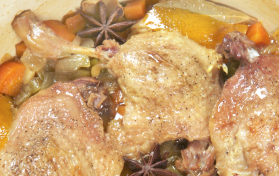
Step 2. The aromatics here include orange zest and star anise (after you strain the liquid save the fat for other stir-fries; it has a great flavor).
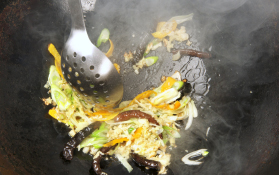
Step 3. To complete the dish, cook the chiles till they’re black, then stir-fry the “Asian mirepoix,” garlic, ginger, and scallions.
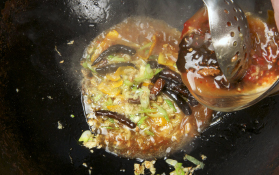
Step 4. Add the sauce and bring it to a simmer.
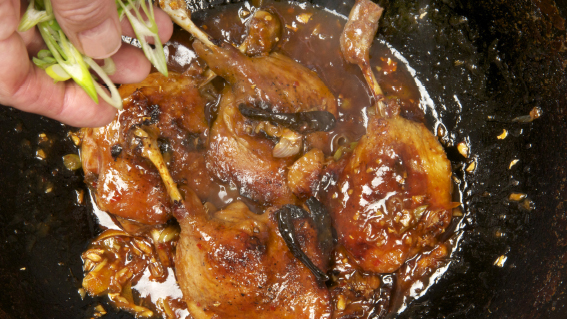
Step 5. Add the duck legs to the simmering sauce and finish with some raw scallion.
